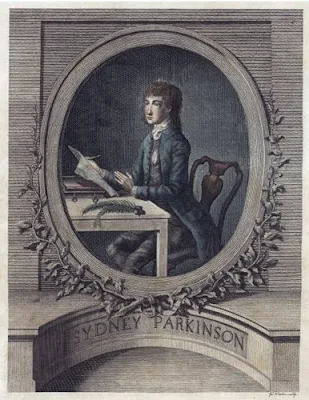 I didn't hear about Sydney Parkinson for a long time. Which is really amazing considering that he is one of the most important botanical and natural history artists who ever lived. His claim to artistic fame is that he sailed as the artist on Captain Cook's first journey around the world on the HMS Endeavour (1768-1771) - a voyage of historical significance and scientific discovery.
I didn't hear about Sydney Parkinson for a long time. Which is really amazing considering that he is one of the most important botanical and natural history artists who ever lived. His claim to artistic fame is that he sailed as the artist on Captain Cook's first journey around the world on the HMS Endeavour (1768-1771) - a voyage of historical significance and scientific discovery.Sydney Parkinson was born in Edinburgh and became very proficient at drawing plants and flowers. He then travelled to London to develop his career as a botanical artist and was discovered by Joseph Banks who was the great sponsor and developer of gardens (eg the Royal Botanic Gardens at Kew) and botanical illustration in general.
Parkinson started the voyage on the Endeavour as one of two botanical artists taken by Captain Cook to draw and paint plants collected on exploratory voyages. However the other artist Alexander Buchan died of epilepsy in Tahiti. This meant that Parkinson became
- the first European artist to set foot on Australian soil,
- the first artist to draw an authentic Australian landscape, and
- the first non-indigenous artist to portray the Aboriginal people of New Zealand and Australia from direct observation.
The Natural History Museum has an absolutely wonderful microsite, on its website, which provides an online exhibition about the Voyage of the Endeavour and the botanical illustrations which resulted. On it you can find the botanical illustrations relating to the different countries visited on the voyage:
- Madeira (12 September 1768)
- Brazil (13th November - 5th December 1768)
- Tierra del Fuego (11th - 21st January 1769)
- Society Islands (13th April - 9th August 1769)
- New Zealand (7th October 1769 - 1 April 1770)
- Australia (19th April - 23rd August 1770)
- Java (11th September - 26th November 1770)
The way the botanical illustrations were produced worked is as follows - based on the records from the Natural History Museum:
- In 1773, Banks employed five watercolourists to complete 595 new artworks based on Parkinson's unfinished work.
- 18 engravers were then employed to cut life size versions (based on 743 artworks) as botanical engravings on copper printing plates - which took until 1784. The 738 engravings they produced enabled scientific publication in colour.
- Various reasons meant that nothing more than proof prints were taken from the engravings while Banks was still alive - and there was no publication.
- Subsequently the engraved copper plates were stored in the British Museum.
- The British Museum (Natural History) - which is the former name of the Natural History Museum - produced lithographic prints of 315 of the Australian plant engravings between 1900-1905.
- In 1973 a further set were published in a bound volume entitled Captain Cook's Florilegium
- In the 1980s the Natural History and the publisher Editions Alecto renovated the copper printing plates and printed the very first complete set of images in colour.
- This project aimed to achieve a limited edition of 100 sets, under the title of Banks' Florilegium. T, would be produced - and took ten years to complete - some 300+ years after the voyage took place
The really sad thing about Sydney Parkinson is that he died - aged just 26 - of fever on the voyage home shortly after they ship left Java. The failure to publish in the eighteenth century meant that his name is not well known.
Just think what he might have produced had he lived! To my mind it is only fit and proper that there is now an increasing level of awareness of what he accomplished on the voyage. I hope with this post and my new information new site that I can help contribute to people knowing more about Sydney Parkinson and what he achieved with his work.
Explorers versus gardeners
As I've been developing my information sites about botanical artists, I've been noticing that they seem to fall into two groups - which I've identified at the beginning of A Compendium of Botanical Art.
There are
- botanical artists who have been associated with exploration and discovery - such as Parkinson, Ferdinand Bauer, who also journeyed to Australia and also recorded the plants of Greece, Maria Sibylla Merian who jouneyed to Surinam in South America and Margeret Mee who lived Brazil and explored the Amazon.
- botanical artists associated with documenting the development of great gardens such as Basilius Besler (Hortus Eystettensis), Franz Bauer (recording all the plants brought back to the Royal Botanic Gardens at Kew), Pierre-Joseph Redouté (documenting the garden and paticurly the roses at Malmaison) and Elizabeth Blackwell (creating a herbal from the plants at Chelsea Physic Garden)
I must confess total ignorance about Sydney Parkinson. Unbelievable for an Australian isn't it! :(
ReplyDeleteWonderful link (yet again) thanks, Katherine. Now I'm wanting to find out exactly how the watercoloured etchings were made. I told you I lack focus!